It is well known that information on the wood structure of trees growing in a country or in a region is indispensable, not only for the taxonomical and systematic studies of these plants, but also for the correct evaluation of the forest resources. In most regions of the world, especially in the old industrialized countries or in the regions where timber has been an important exportable good, such anatomical information has been accumulated through the efforts of many students since the last century. On the other hand, in the developing countries or in the regions where timber has less commercial value due to the lack of means of carrying it out to the market, wood anatomical information is rather scarce or wanting entirely. The Himalayan region, the top of the world, is characterized by the highest mountains and many valleys with abysmal ravines. This precipitous topography has obstructed the transportation of timber and also scientific research on the Himalayan woods.
The usual method of wood anatomy is to obtain wood samples from commercial timbers in the markets or by felling down living trees. Market samples are often uncertain as to their specific identity and thus less valuable for wood anatomical study. In the Himalayan region, felled down trees cannot be brought down due to the lack of any roads accessible to the mountains, and, what is more important, living trees cannot be cut down indiscriminately because of the forest conservation. Therefore, we thought of a fine and easy method of collecting wood specimens without felling the trees.
In our botanical expeditions to central Nepal in 1983 and 1985, we collected more than 800 wood samples by this new method. With a chisel, a hammer and a small saw, a small cubic block (2-3 cm in aide length) of wood was chipped out from the outermost part of an erect trunk. Therefore, our wood specimens are usually made of outer sap wood, sometimes with a small portion made of heart wood. The blocks were fixed and preserved in diluted Formaldehyde. After softening in boiling water, thin sections, 20-40 µm in thickness, were cut by using a sliding microtome. The sections were stained in Safranin O and Fastgreen FCF and were mounted in Merck's Entellan New.
Microscopic slides were observed with light microscopes. In the present paper, we report on the wood structure of several families. This is the first part of a aeries of anatomical descriptions of Himalayan woods; the remaining families will be reported successively. Only the static anatomical features are described in the present paper, without any morphological or taxonomical discussion. We think that this primary data is useful to most students, and we hope that, based on the present paper and the microscopic slides distributed in the laboratories and institutes described below, studies of comparative wood anatomy, phylogeny and other aspects of these plants will follow.
The microscopic slides will be sent to the following laboratories: Botanical Survey and Herbarium, Department of Medicinal Plants, Ministry of Forestry and Soil Conservation, H.M.G., Nepal; Department of Biology, College of Liberal Arts, Kanazawa University; Department of Botany, University Museum, University of Tokyo; Department of Biology, Faculty of Science, Osaka City University; Wood Research Institute, Kyoto University; Wood Technology Division, Forestry and Forest Products Research Institute Japan; and a few certain laboratories in the world. The voucher specimens will be deposited in University Museum, University of Tokyo; Department of Biology, College of Liberal Arts, Kanazawa University; and Botanical Survey and Herbarium, Department of Medicinal Plants, Ministry of Forestry and Soil Conservation, H.M.G., Nepal.
We are indebted to Director-General Dr. S. B. Malla and all the staff of the Department of Medicinal Plants, Ministry of Forestry and Soil Conservation, H.M.G., Nepal for their help and hospitality in the course of our study. Thanks are also due to Dr. Takasi Yamazaki, University of Tokyo, for his critical identification of the voucher specimens, and to Mr. Kiyotsugu Yoda, Department of Biology, Faculty of Science, Kanazawa University, for his help in the preparation of the microscopic slides.
TAXACEAE (Mitsuo SUZUKI)
Taxus baccata L. subsp. wallichiana (Zucc.) Pilger
[Plate 52]
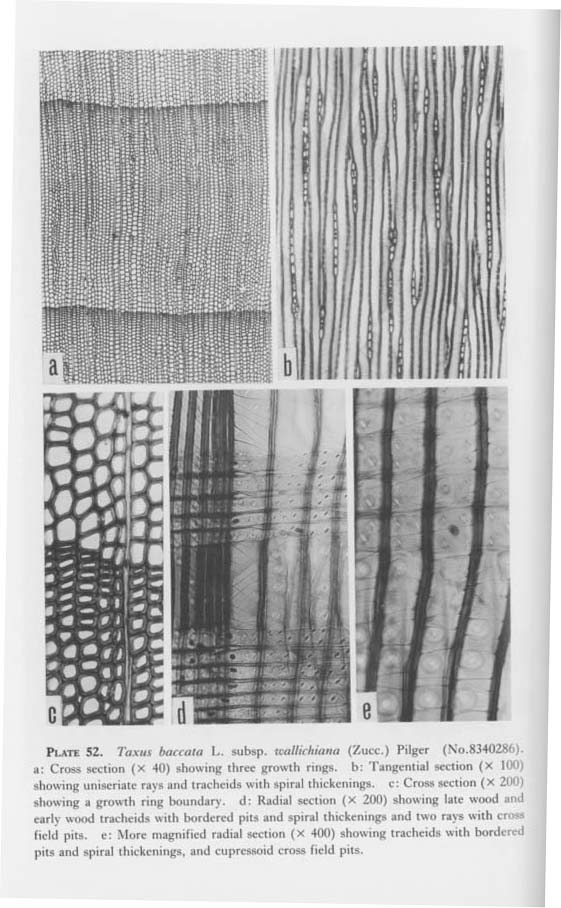
An evergreen coniferous tree growing mainly in the upper part of the temperate zone.
SPECIMENS. No. 8340110, d=100 cm, h=15 m, alt. 2340 m: Dhaulagiri Zone, Parbat Dist., Ghandruk (1950 m)-Ghandruk Deorali (2530 m), H. Ohba et al., July 10, 1983. No. 8340286*, d=25 cm, h=7 m, alt. 2850m; Marsyandi Khola, Bardang (2850 m)-Chame (2630 m), H, Ohba et al., Aug. 5,1983. No. 8540128, d=12 cm, h=5 m, alt. 2310 m: Bagmati Zone, Rasuwa. Dist., Pati Bhanjyang (1780m)-Borong Bhanjyang (2120 m)-Siopuri Danda (2700 m)-Ani Gompa (1980 m), M. Suzuki & S. Noshiro, June 5, 1985.
DESCRIPTION. This is a coniferous wood made of tracheids and ray parenchyma.Annual rings are distinct and fine; quite variable in width, 0.1-2.7 mm or more. Transition from early to late wood is faintly gradual and no distinct boundary is found in the transition zone.
Tracheids in the early wood are polygonal or square in cross section and the diameter is variable within a growth ring; 25-45 and 20-35 µm in. radial and tangential diameters respectively; thin-walled (about 3 µm). Late wood tracheids are smaller in diameter and a little thicker in wall thickness (about 5 µm) than the early wood tracheids; 10-20 µm in radial diameter. Distinct spiral thickenings are present. Bordered pits are usually in uniseriate rows, but sometimes biseriate with crassulae. Bordered pits are round in outline, 15-20 µm in diameter, with small elliptical apertures and fine torus. Small tangential pits are abundant on the tracheids at the end and the beginning of the annual rings; about 10 µm in diameter with very small apertures.
Resin cells are absent.
Rays are uniseriate and made of parenchymatous cells. Ray height is mostly 1-15 cells and sometimes up to 20 cells or more. Ray cells are vertically long and elliptical, 15-35 and 10-15 µm in vertical and tangential diameters respectively. Walls are thin and smooth. Crystals are invisible. Cross field pits are half-bordered and small, 5-7 µm in diameter, with small elliptical or slit-like apertures (cupressoid to piceoid); there are one or two pits in a field, while pits are more numerous in the fields of marginal ray cells.
CUPRESSACEAE (Mitsuo SUZUKI)
Cupressits torulosa D. Don
[Plate 53]
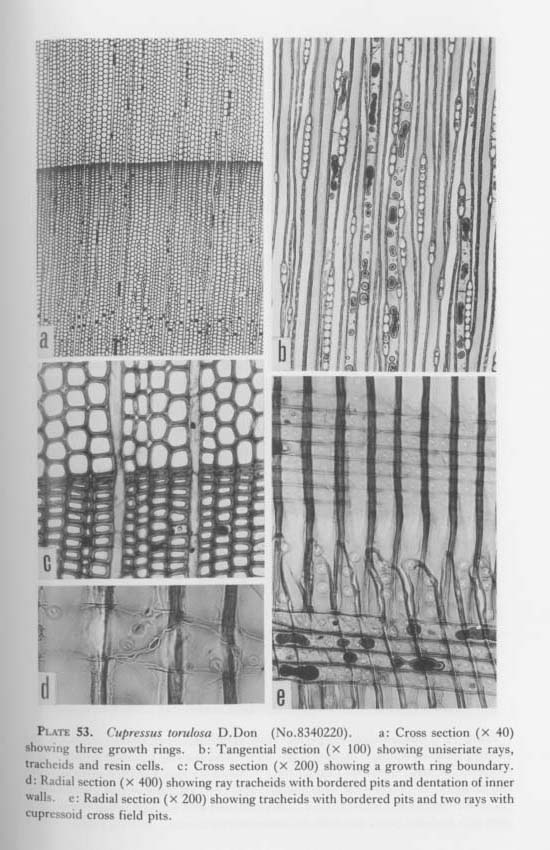
An evergreen coniferous tree growing in fairly dry areas of the temperate zone.
SPECIMEN. No. 8340220*, d=50 cm, h=10 m, alt. 2600 m: Kali Gandaki, Kalopani (2570 m)-Ghatte Khola (2570 m)-Larjung (2600 m)-Tukche (2680m), H. Ohba et al., July 18,1983.
DESCRIPTION. This is a coniferous wood consisting of tracheids, resin cells, ray parenchyma and ray tracheids. Annual rings are distinct and wide, 1.5-3.9 mm, in the specimen examined. Transition from early to late wood is gradual and late wood is fairly narrow.
Tracheids in the early wood are square to polygonal with round corners in cross section; 25-50 and 15-40µm in radial and tangential diameters respectively; thinwalled (about 3µm). Late wood tracheids are fairly small in radial diameter; about 10 µm in the radial diameter of the smallest tracheids, in which wall thickness is about 4 µm and the lumen is quite narrow and linear. Bordered pits are usually in a uniseriate row and rarely in opposite biseriate rows with crassulae. Bordered pits are round in outline and small, 12-15 µm in diameter, with small elliptical apertures and fine torus. Small tangential pits are abundant on the tracheids at the end and the beginning of the annual rings; about 8-10 µm in diameter with narrow elliptical apertures.
Resin cells, which are in strands, are abundant and diffused within the annual rings and crowded in loose tangential bands. Horizontal walls of the resin cells are thin and smooth, or thick and pitted (nodular). Rays are uniseriate and constituted from parcnchymatous cells and more or less sporadic ray tracheids. Ray height is mostly 1-20 cells and rarely up to 30 cells or more. Ray parenchyma cells are vertically long-elliptical or oval in tangential section, 25-30 and 13-25µm, in vertical and tangential diameters respectively. Walls are thick and smooth. Ray tracheids are sometimes at the marginal portion of rays. Crystals are invisible in both kinds of ray cells. Cross field pita are half-bordered and small, 6-8 µm in diameter, with large apertures and narrow borders (taxodioid); pits are 1-3 in a field, while more numerous in fields of marginal ray cells.
Juniperus indica Bertol.
[Plate 54]
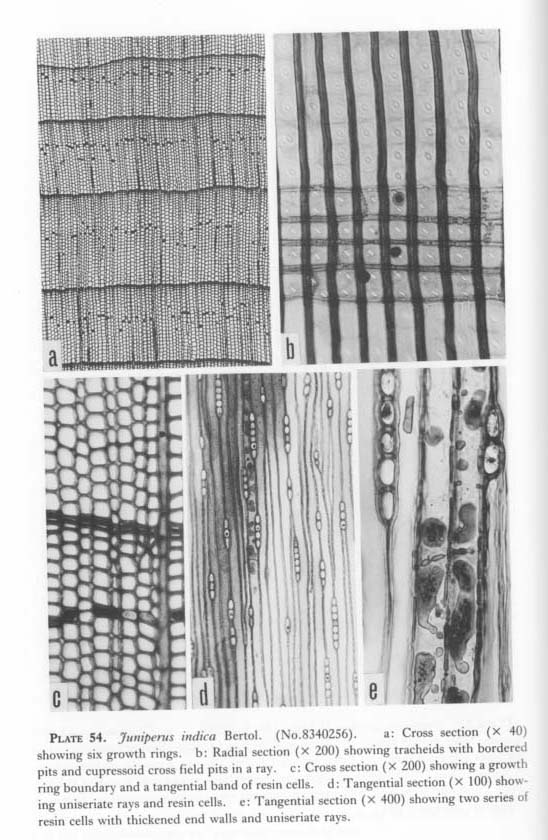
An evergreen conifer growing from the upper sub-alpine zone to the lower alpine zone. Plants which are growing in the sub-alpine zone are usually in tree form but those in the alpine zone are creeping shrubs.
SPECIMENS. No, 8340234. d=25 cm, h=6 m, alt. 3930 m; No. 8340240, d=20 cm, h=6 m, alt. 3700 m: Gandaki Zone, Manangbhot Distr., Khangsar (3650 m)-Tilicho Base Camp (4000 m), H. Ohba et al., July 30, 1983. No. 8340256*, d=35 cm, h=6m, alt. 3320m: Marsyandi Khola, Humde (3320 m)-Pisang (3130 m)-Deorali Danda (3050 m)-Bardang
(2850 m), H. Ohba et al., Aug. 4, 1983. No. 8540057, d=2.5 cm, h=0.5 m, alt. 3970m: Bagmati Zone, Rasuwa Distr., Langtang (3380 m)-Langtang Lirung Glacier Moraine (3910 m)-Kyangjin Gompa (3800 m), M. Suzuki & S. Noshiro, May 26, 1985.
DESCRIPTION. This is a coniferous wood made of tracheids, resin cells and ray parenchyma. Annual rings are fine and distinct; fairly narrow, 0.2-2.1 mm. Transition from early to late wood is abrupt and late wood is very narrow with one to about ten cells.
Tracheids in the early wood are square to polygonal in cross section; 15-30 and 15-25 µm in radial and tangential diameters respectively; thin-walled (less than 2 µm). Late wood tracheids are smaller in radial diameter with a little thicker walls (about 2.5 µm); 8-10 µm in radial diameter. Bordered pits are usually in a uniseriate row with crassulae. Bordered pits are round in outline and small, 12-15 µm in diameter, with small round apertures and fine torus. Small tangential pits are abundant on the tracheids at the end and the beginning of the annual rings; about 8 µm in diameter with small elliptical apertures.
Resin cells, which are in strands, are abundant and diffused within the annual rings forming loose tangential bands. Horizontal walls of the resin cells are thick and pitted (nodular).
Rays are uniseriate and constituted from parenchymatous cells. Rays are fairly low; mostly 1-6 cells and rarely up to 10 cells or more. Ray cells are vertically long-elliptical or oval in tangential section, 15-35 and 10-15 µm in vertical and tangential diameters respectively. Horizontal walls are a little thick and sometimes pitted. Vertical walls are a little thick and densely pitted (nodular). Crystals are invisible. Cross field pits are half-bordered and small, about 5 µm in diameter, with elliptical apertures and narrow borders (cupressoid); pits are 2 or 1 in a field, while more numerous in fields of marginal ray cells.
Juniperus recura Buch.-Ham. ex D. Don
[Plate 55]
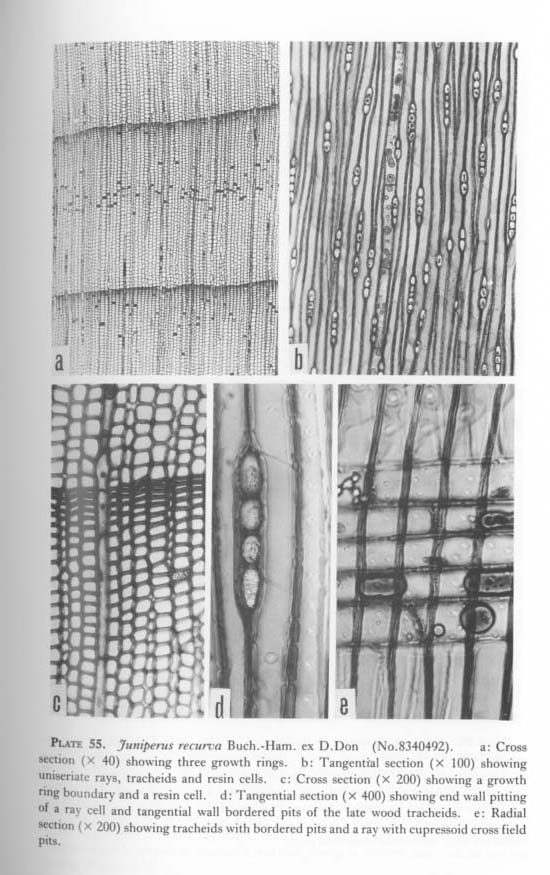
An evergreen conifer growing from the sub-alpine zone to the lower alpine zone. Plants in the sub-alplne zone are usually in tree form but those in the alpine zone are creeping shrubs.
SPECIMENS. No. 8340479, d=40 cm, h=10 m, alt. 3230 m; Rolwaling Khola, Tandingma (3200 m)-Nimare (3450 m)-Beding (3600 m), H. Ohba et al., Sept. 2, 1983. No. 8340492*, d=25 cm, h=6 m, alt. 3740 m: Rolwaling Khola, Beding (3600 m)-Na (4050 m), H. Ohba et al., Sept. 4, 1983. No. 8540106, d=25 cm, h=6 m, alt. 3400 m; Bagmati Zone, Rasuwa Dist., Shin Gompa (3200 m)-Gosainkund (4300 m), M. Suzuki & S. Noshiro, June 1, 1985. No. 8540159, d=25 cm, h=8 m, alt. 3310 m: Janakpur Zone, Ramechhap Distr., Deorali (2700 m)-Thodung (3000 m)-Serdingma (3400 m), H. Ohba et al., July 6, 1985. No. 8540245, d=5 cm, h=1.2 m, alt. 3810 m: Sagarmatha Zone, Solukhumbu Dist., Beni Kharka (3970 m)-Sarkari Pati (3350 m), H. Ohba et al., Sept, 2, 1985.
DESCRIPTION. It is a coniferous wood consisting of tracheids, resin cells and ray parenchyma. Annual rings are fine and distinct; narrow to a little wide, 0.2-3.2 mm. Transition from early to late wood is abrupt and late wood is very narrow with one to about ten cells.
Tracheids in the early wood are square to polygonal with round corners in cross section; 20-32 and 20-30 µm in radial and tangential diameters respectively; thinwalled (about 2.5 µm). Late wood tracheids are smaller in radial diameter (10-15 µm) with a little thicker walls (2.5-3.8 µm). Bordered pits are usually in a uniseriate row with crassulae; round in outline and small, 12-15 µm in diameter, with small round apertures and fine torus. Small tangential pits are abundant on the tracheids at the end and the beginning of the annual rings; about 8 µm in diameter with small elliptical apertures.
Resin cells, which are in strands, are abundant and diffused within the annual rings forming loose tangential bands. Horizontal walls of the resin cells are thick and pitted (nodular).
Rays are uniseriate and constituted from parenchymatoua cells. Ray height is mostly 1-10 cells and rarely up to 16 cells or more. Ray cells are vertically long-elliptical or oval in tangential section, 15-35 and 10-15
m in vertical and tangential diameters respectively. Horizontal walls are thick and sometimes pitted. Vertical walls are thick and densely pitted (nodular). Crystals are invisible. Cross field pits are half-bordered and small, about 5 µm in diameter, with elliptical apertures and narrow borders (cupressoid); pits are 2 or 1 in a field, while more numerous in fields of marginal ray cells.
Juniperus squamata Buch.-Ham. ex D. Don
[Plate 56]
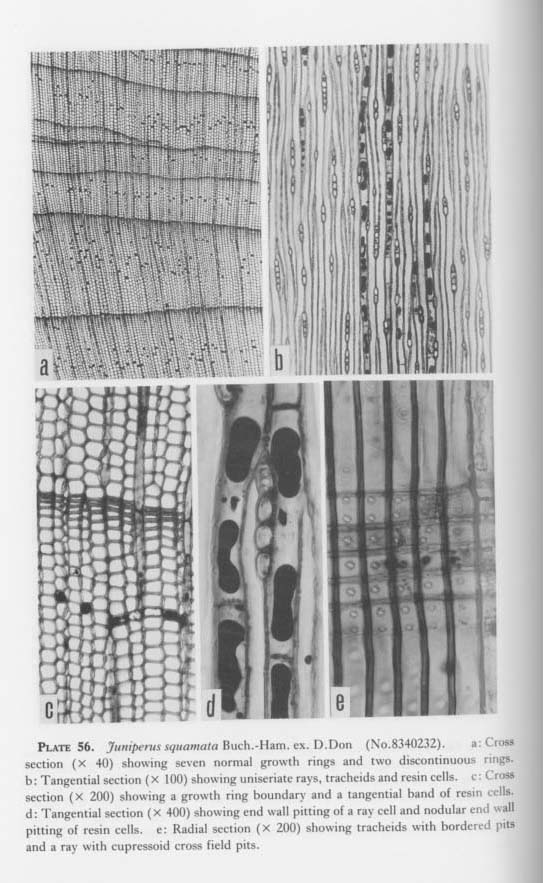
An evergreen coniferous creeping shrub growing from the upper sub-alpine zone to the lower alpine zone.
SPECIMENS. No. 8340229, d=8 cm, h=0.8 m, alt. 4100 m; No. 8340232*, d=8 cm, h=0.5 m, alt. 3950 m: Gandaki Zone, Manangbhot Dist., Thanti (4080 m)-Tenki (3650 m)-Manang (3550 m), H. Ohba et al., July 28, 1983.
DESCRIPTION. A coniferous wood made of tracheids, resin cells, ray parenchyma, and sometimes traumatic tissue. Annual rings are fine, distinct and sometimes discontinuous; quite narrow with only several rows of tracheids to narrow, 0.03-1.3 mm. Transition from early to late wood is abrupt in the narrower rings and moderate in the wider rings; the late wood is very narrow with one to ten or more cells. Resin cells are mostly in the eary wood.
Trachcida in the early wood are square to polygonal in cross section; 15-22 and 15-22 µm in radial and tangential diameters respectively; thin-walled (about 1.5 µm). Late wood tracheids are fairly smaller in radial diameter (about 8 µm) with a little thicker walls (about 2.5 µm). Bordered pits are usually in a uniseriate row with crassulae. Bordered pits are round in outline and small, 15-18 µm in diameter, with small round apertures and fine torus. Small tangential pits are abundant on the tracheids at the end and the beginning of the growth rings; 5-8 µm in diameter with small elliptical apertures.
Resin cells, which are in strands, are abundant and diffused within the annual rings forming loose tangential bands. Horizontal walls of the resin cells are thick and pitted (nodular).
Rays are uniseriate and constituted from parenchymatous cells. Ray height is mostly 1-8 cells and sometimes up to 10 cells or more. Ray cells are vertically long-elliptical or oval in tangential section, 15-25 and 10-15 µm in vertical and tangential diameters respectively. Horizontal walls are a little thick-walled and sometimes pitted. Vertical
walls are a little thick and densely pitted (nodular). Crystals are invisible. Cross field pits are half-bordered and small, about 4 µm in diameter, with elliptical apertures and narrow borders (cupressoid); pits are 1-3 in a field, while more numerous in fields of marginal ray cells.
PINACEAE (Mitsuo SUZUKI)
Abies spectabilis (D. Don) Mirb. [Plate 57]
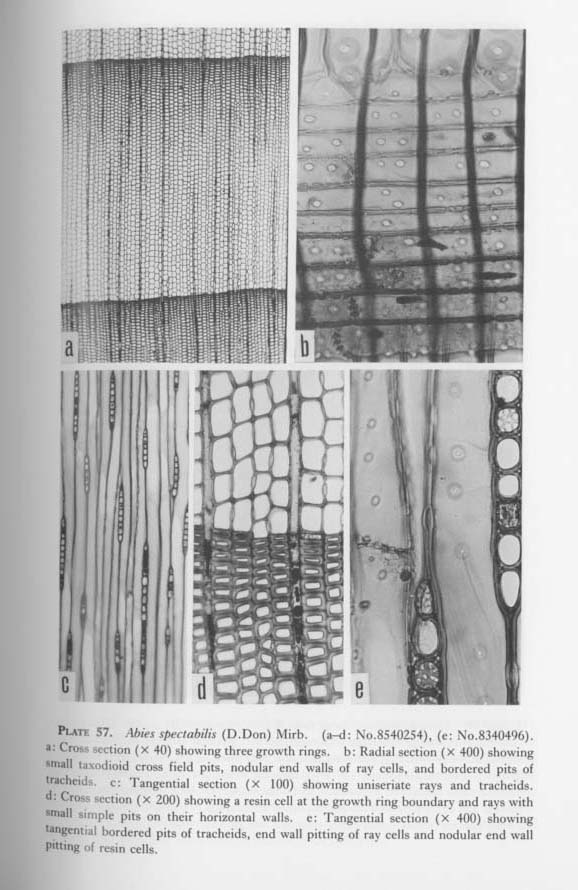
A big evergreen conifer which is the main constituent of the sub-alpine forest in Nepal.
SPECIMENS. No. 8340134, d=90 cm, h=25 m, alt. 2710 m; No. 8340157, d=30 cm, h=8 m, alt. 3110 m: Dhaulagiri Zone, Parbat Dist., Banthanti (2650 m)-Gorepani Deorali (3170 m), H. Ohba et al. July 12, 1983. No. 8340254*, d=25 cm, h=6 cm, alt. 3460 m: Marsyandi Khola, Manang (3550 m)-Humde (3320 m), H. Ohba et al., Aug. 3, 1983. No. 8340496; d=25 cm, h=6m, alt. 2930 m: Khare Khola, Patale Pokhari (4000 m)-a pass (4200 m)-Phedi Kharka (2100 m), H. Ohba etal., Sept. 13, 1983. No. 8540104, d=25 cm, h=7 m, alt. 3130 m: Bagmati Zone, Rasuwa Dist., Syabru (2240 m)-Shin Gompa (3200 m), M. Suzuki & S. Noshiro, May 28, 1985.
DESCRIPTION. A coniferous wood made of tracheids, ray parenchyma and resin cells. There were no traumatic resin canals in the specimens examined. Annual rings are distinct and variable in width, 0.2-5.0 mm or more wide. Transition from early to late wood is gradual and no distinct boundary is found in the transition zone.
Tracheids in the early wood are square or rectangular in cross section; 20-40 and 15-34 µm in average radial and tangential diameters respectively; thin-walled (less than 2 µm). Late wood tracheids are smaller in radial diameter and thicker in wall thickness (2.5-3 µm) than the early wood tracheids; 8-16 µm in radial diameter. Bordered pits are usually in uniseriate rows and rarely in opposite biseriate rows with crassulae. Bordered pits are round in outline, 18-25 µm in diameter, with small round apertures and fine torus. Small tangential pits are abundant on the tracheids at the end and the beginning of the annual rings; about 8 µm in diameter with very narrow apertures.
Resin cells, which are in strands, are sometimes present at the boundary of annual rings, Walls of the resin cells are thick with simple pits.
Rays are uniseriate and constituted from parenchymatous cells. Ray height is mostly 1-12 cells, 6.7-7.8 cells in average, and rarely up to 30 cells or more. Ray cells are vertically long-elliptical, 15-30 and 10-20 µm in vertical and tangential diameters respectively. Vertical and horizontal walls are thick with dense simple pits. Pita are especially dense on the end walls. Crystals are invisible. Cross field pits are half-bordered and small, 6-8 µm in diameter, with large apertures and narrow borders (taxodioid); pits are 1-3 in a field, while more numerous in fields of marginal ray cells.
Larix himalaica Cheng et L. K. Fu [Plate 58]
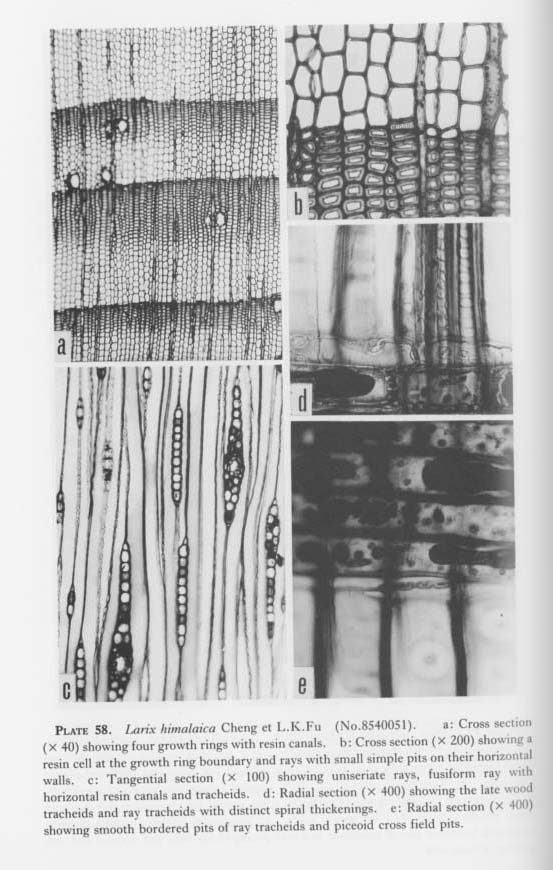
A deciduous conifer growing in the upper sub-alpine zone.
SPECIMENS. No. 8540051*, d=35 cm, h=5 m, alt. 3130 m: Bagmati Zone, Rasuwa Dist., Lama Hotel (2480 m)-Ghora Tabela (3000 m)-Langtang (3380 m), M. Suzuki & S. Noshiro, May 25, 1985. No. 8540060, d=18 cm, h=4m, alt. 3720 m: Bagmati Zone, Rasuwa Dist., Kyangjin Gompa (3800 m)-Langtang (3380 m), M. Suzuki & S. Noshiro, May 28, 1985.
DESCRIPTION. A coniferous wood consisting of tracheids, ray parenchyma and ray tracheids, vertical and horizontal resin canals, and resin cells. Vertical resin canals are not scattered equally in the annual rings; sometimes solitary, in pairs or in loose tangential groups; 40-100 µm in tangential diameter including epithelial cells. Annual rings are distinct and variable in width, 0.3-2.6 mm. Transition from early to late wood is gradual in the wider rings and abrupt in the narrower rings.
Tracheids in the early wood are square or rectangular in cross section; 30-60 and 20-45 µm in radial and tangential diameters respectively; thin-walled (less than 1.5 µm). Late wood tracheids are small in radial diameter (12-20 µm) and thick-walled (about 4 ,µm or more) with linear lumen. Bordered pits are usually in uniseriate rows and in opposite biseriate rows with crassulae. Bordered pits are round in outline, 16-25 µm in diameter, with small round apertures and distinct torus. Small tangential pits are abundant on the tracheids at the end and the beginning of the annual rings; 6-8 µm in diameter with very narrow apertures. Spiral thickenings are distinct in the late wood tracheids but invisible in the early wood tracheids.
Resin cells, which are in strands, are sometimes present at the boundary of annual rings. Walls of the resin cells are thick with dense simple pits.
Rays are uniseriate and fusiform; consisted of parenchymatous cells, ray tracheids and epithelial cells of resin canals. Height of uniseriate rays is mostly 1-20 cells and sometimes more cells. Ray parenchyma cells are vertically long-elliptical or oval in tangential view, 20-35 and 15-25 µm in vertical and tangential diameters respectively. Vertical and horizontal walls are thick and pitted densely by simple pits. Ray tracheids are in one or two rows at the margin of rays; usually smooth and rarely with dentation or spiral thickenings on the inner surface; slender triangles or ellipses in the tangential view and smaller than the parenchymatous cells. Fusiform rays are usually compact in outline and sometimes with high uniseriate wings, 300-700 µm or more in. height and 50-75 in tangential width with usually one horizontal canal. Epithelial cells of resin, canals are thin to thick-walled; 6-11, mostly 7-9 cells, per canal. Crystals are invisible in all ray cells, Cross field pits are half-bordered and small, 4-6 µm in. diameter, with slit-like or sometimes elliptical apertures and wide to narrow borders (piceoid or sometimes cuprossoid); pits are numerous; 4-6 in a field.
Picea smithiana (Wall.) Boiss. [Plate 59]

An evergreen conifer growing from the lower sub-alpine zone to the upper evergreen broad-leaved forest.
SPECIMENS. No. 8340280, d=10 cm, h=3 m, alt. 2950 m; No. 8340281*, d=30 cm, h=10 m, alt. 2950m: Marsyandi Khola, Humde (3320m)-Pisang (3130 m)-Deorali Danda (3050 m)-Bardang (2850 m), H. Ohba et al., Aug. 4, 1983. No. 8340285, d=50 cm, h=15 m, alt. 2850 m: Marsyandi Khola, Bardang (2850 m)-Chame (2630 m), H. Ohba et al., Aug. 5, 1983.
DESCRIPTION. A coniferous wood made of tracheids, ray parenchyma, ray tracheids, and vertical and horizontal resin canals. Vertical resin canals are scattered unevenly in the annual rings; solitary, in pairs or sometimes in loose groups of several canals; 40-140 µm in tangential diameter including epithelial cells. Growth rings are distinct and fairly wide, 0.3-4.1 mm. Transition from early to late wood is gradual.
Tracheids in the early wood are square or rectangular in cross section; 35-60 and
20-45 µm in radial and tangential diameters respectively; thin-walled (about 2 µm). Late wood tracheids are small in radial diameter (10-20 µm) and thick-walled (about 5 µm). Bordered pits are usually in uniseriate rows with crassulae. Bordered pits are round in outline, 15-20 µm. in diameter, with small round or elliptical apertures and fine torus. Small tangential pits are abundant on the tracheids at the end and the beginning of the growth rings; 10 µm in diameter with very narrow apertures. Spiral thickenings are distinct both in the early and late wood tracheids but invisible in the late wood tracheids of the specimen No. 8340281.
There were no resin cells in the specimens examined.
Rays are uniseriate and fusiform; made of parenchymatous cells, ray tracheids and epithelial cells of resin canals. Height of uniseriate rays is mostly 1-30 cells or more. Ray parenchyma cells are vertically long-elliptical or oval in tangential view, 15-25 and 12-20 µm in vertical and tangential diameters respectively. Vertical and horizontal walls are thin at the outermost part of trunk and thick in the inner parts; when it is thick, simple pits are dense. Ray tracheids are in one or two rows at the margin of rays and sometimes one or two rows are mixed among rows of parenchyma cells at central portions of rays; slender triangles or ellipses in the tangential view and fairly smaller than the parenchymatous cells; usually with distinct spiral thickenings on the inner surface. Fusiform rays have one or sometimes two horizontal resin canals; usually with compact fusiform outline and sometimes more slender with high uniseriate wings; 300-600 µm or more in height and 45-55 µm in tangential width. Epithelial cells of resin canals are thin or thick-walled; 6-8, mostly 7 cells, per canal. Cross field pits are half-bordered and small, 4-6 µm in diameter, with slit-like or sometimes elliptical apertures and wide to narrow borders (piceoid); pits are moderately numerous: 3 or 2 in a field, Crystals are sometimes present in the parenchymatous cells at the margin of rays.
Pinus roxburghii Sarg. [Plate 60]
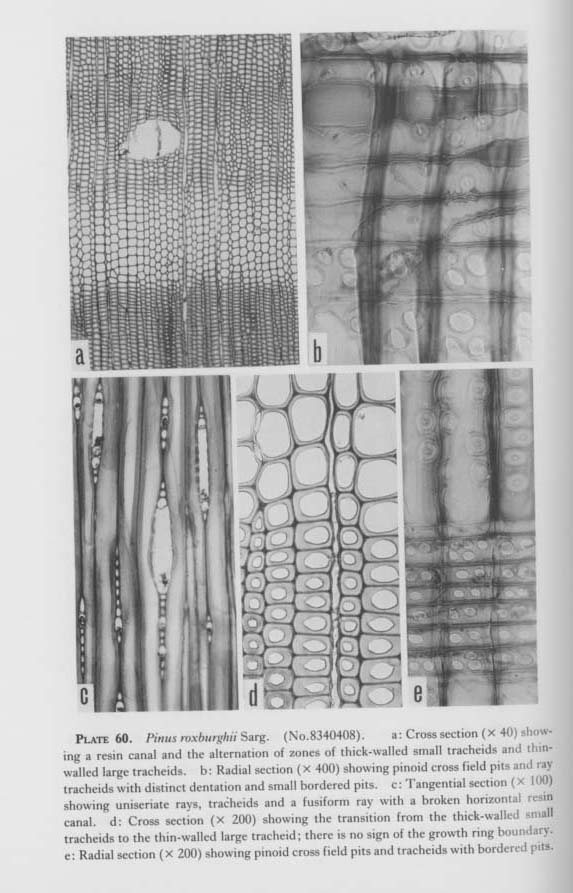
A three-leaved evergreen pine growing or planted in the subtropical zone.
SPECIMEN. No. 8340408*, d=35 cm, h=13 m, alt. 950 m: Tamba Kosi, Dolakha (1700 m)-Malephu (900 m)-Kosikhet (1000 m)-Pikhuti (950 m), H. Ohba et al., Aug. 27, 1983.
DESCRIPTION. A coniferous wood consisting of tracheids, ray parenchyma, ray tracheids, and vertical and horizontal resin canals. Vertical resin canals are very large (300-450 µm in tangential diameter including epithelial cells) and distributed evenly in the wood. There are distinct growth rings formed by alternations of the zone of thinwalled thick tracheids and the zone of thick-walled narrow tracheids. Transition from the zone of the thick tracheids to the zone of the narrow tracheids is abrupt to gradual and the latter zone is usually wider than the former in the specimen investigated; 0.6-1.0 mm in width in the former zone and 1.9-3.0 mm in width in the latter; false annual ring-like undulation in tracheid size and cell wall thickness is often observed in the latter zone.
Tracheids in the thick tracheid zone are square or rectangular with round corners in cross section; 38-70 and 25-58 µm in radial and tangential diameters respectively; thin-walled (2.5-3 µm). Tracheids in the narrow tracheid zone are small in radial diameter and thick-walled; 25-38 and 22-50 µm in average radial and tangential diameters respectively; although the outline in the cross section is tangentially long rectangular but the outline of the lumen is round or elliptical because of a difference in thickness between the radial and tangential walls; several-13 µm or more in the tangential wall thickness while only up to 5 or 6 µm in the radial wall. Bordered pits are usually in uniseriate rows and in opposite biseriate rows at the ends of tracheids with crassulae. Bordered pits are round in outline, 25-35 µm in diameter, with round apertures and distinct torus. Spiral thickenings are invisible.
Resin cells were invisible in the specimen investigated.
Rays are uniseriate and fusiform; made of parenchymatous cells, ray tracheids and epithelial cells of resin canals. Height of uniseriate rays is 1-12 cells or more, mostly 2-7 cells. Ray parenchyma cells are vertically long-elliptical or oval in tangential view, 25-40 and 15-25 µm in vertical and tangential diameters respectively; lateral walls often swollen into neighboring tracheids. Vertical and horizontal walls are thin to thick; smooth and sometimes pitted. Ray tracheids are rather abundant and in one to four rows; often with dentation on the inner surface. Fusiform rays have one horizontal resin canal; quite uniform in size, 350-650 µm in height and 50-70 µm in tangential diameter. Epithelial cells of resin canals are very thin-walled and usually deformed in the microscopic slides. Crystals are invisible. Cross field pits are variable in shape and size, 12-25 µm in diameter, and pinoid with distinct borders; 1-4, mostly 2 or 3, pits in a field.
Pinus wallichiana A. B. Jackson [Plate 61]
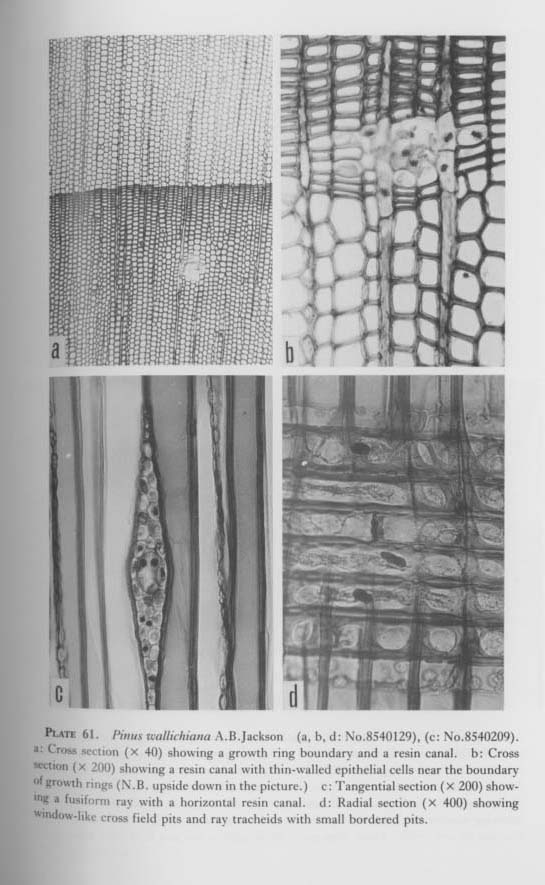
This five-leaved evergreen pine grows or is planted widely in the temperate regions in Nepal.
SPECIMENS. No. 8340209, d=40 cm, h=15 m, alt. 2410m: Kali Gandaki, Ghasa (2100 m)-Lete (2400 m)-Kalopani (2570 m), H. Ohba et al., July 17,1983. No. 8540129*, d=12 cm,h=5 m, alt, 2010 m: Janakpur zone, Dolakha Distr., Jiri (1860 m)-Bhakal (2020 m)-Ratmate (2270 m)-Maligaon (2200 m)-Shivalaya (1800 m), H. Ohba et al., July 4, 1985.
DESCRIPTION, A coniferous wood consisting of tracheids, ray parenchyma, ray tracheids, and vertical and horizontal resin canals. Vertical resin canals are usually present in the late wood while sometimes found within the early wood; usually solitary; to measure the diameter of resin canals is fairly difficult because they are broken easily; about 100-150 µm in tangential diameter including epithelial cells. Annual rings are distinct and variable in width, 0.3-8.5 mm. Transition from early to late wood is gradual.
Tracheids in the early wood are square or rectangular in cross section; 40-65 and 30-60 µm in radial and tangential diameters respectively; thin-walled (2.5-3.5 µm). Late wood tracheids arc small in radial diameter (down to 10 µm) and thick-walled (about 5 µm). Bordered pits are usually in uniseriate rows and in opposite biseriate rows at the ends of tracheids, with crassulae. Bordered pits arc round in outline, 20-30 µm in diameter, with round apertures and distinct torus. Small tangential pits are abundant on the tracheids at the end and the beginning of the annual rings; about 7.5 µm in diameter with very narrow apertures. Spiral thickenings are invisible.
Resin cells were invisible in the specimens investigated.
Rays are uniseriate and fusiform; consisting of parenchymatous cells, ray tracheids and epithelial cells of resin canals. Height of uniseriate rays is mostly 1-16 cells. Ray
parenchyma cells are vertically long-elliptical or oval in tangential view, 15-20 and 10-15 µm in vertical and tangential diameters respectively; lateral walls often swollen into the neighboring tracheids. Vertical and horizontal walls are quite thin at the outermost part of the trunk but immediately become thick in the inner part; thick horizontal walls are smooth or partly pitted by dense simple pits; thick vertical walls are usually nodular. Ray tracheids are in one or two rows at the margin of rays; the inner surface of walls is usually smooth. Fusiform rays are uniform in spindle-like shape and size (250-500 µm in height and 45-55 µm in tangential width) with one horizontal resin canal. Epithelial cells are very thin-walled and usually four cells per canal. Crystals are invisible. Cross field pits are large and window-like with fine borders; pits are usually one and sometimes two in a field.
Pinus wallichiana A. B. Jackson var. manangensis H. Ohba et M. Suzuki1) [Plate 62]
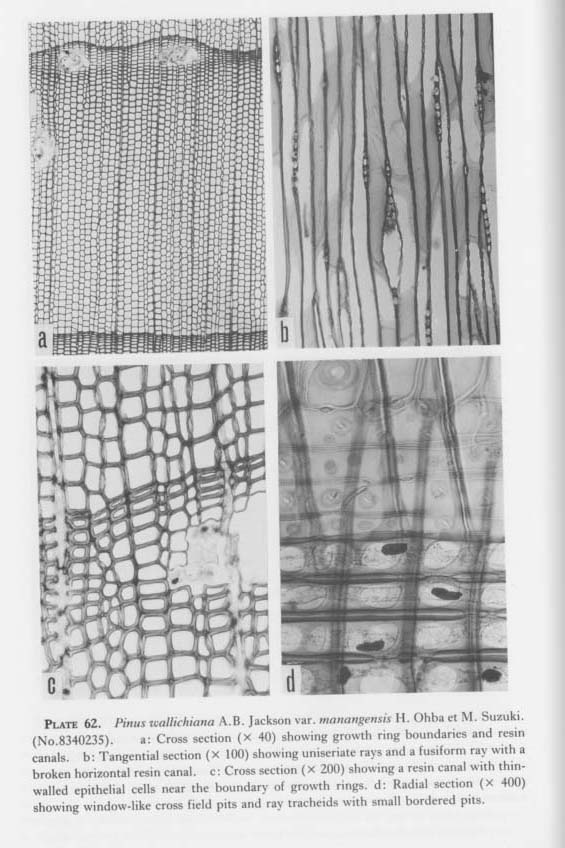
A five-leaved evergreen pine growing in the dry sub-alpine zone.
SPECIMENS. No. 8240235*, d=50 cm, h=12m, alt. 3620 m: Gandaki Zone, Manangbhot Dist., Manang (3550 m)-Khangsar (3650 m), H. Ohba et al., July 29, 1983. No. 8340255, d=40 cm, h=12 m, alt. 3460 m: Marsyandi Khola, Manang (3550m)-Humde (3320m), H. Ohba et al., Aug. 3, 1983.
DESCRIPTION. A coniferous wood consisting of tracheids, ray parenchyma, ray tracheids, and vertical and horizontal resin canals. Vertical resin canals are usually present in the late wood while sometimes found within the early wood: usually solitary; to measure diameter of resin canals is fairly difficult because they are broken easily; about 150-200 µm in tangential diameter including epithelial cells. Annual rings are distinct and variable in width, 0.2-2.4 mm. Transition from early to late wood is gradual and late wood is quite narrow with several to ten or more cells.
Tracheids in the early wood are square or rectangular in cross section; 37-63 and 25-45 µm in radial and tangential diameters respectively; thin-walled (about 2 µm). Late wood tracheids are small in radial diameter (down to 8 µm) and thick-walled (about 4 µm). Bordered pits are usually in uniseriate rows and in opposite biseriatc rows at the ends of tracheids, with crassulae. Bordered pits are round in outline, 20-30 µm in diameter, with round apertures and distinct torus. Small tangential pits are abundant on the tracheids at the end and the beginning of the annual rings; 8-10 µm in diameter with narrow apertures. Spiral thickenings are invisible.
Resin cells were invisible in the specimens investigated.
Rays are uniseriate and fusiform; made of parenchymatous cells, ray tracheids and epithelial cells of resin canals. Height of uniseriate rays is mostly 1-12 cells. Ray parenchyma cells are vertically long-elliptical or oval in tangential view, 20-30 and 10-18 µm in vertical and tangential diameters respectively; lateral walls often swollen intoneighboring tracheids. Vertical and horizontal walls are quite thin in the outermost several annual rings of the trunk but become thick gradually in the inner part; walls are more or less thick and smooth or pitted by simple pits (nodular). Ray tracheids are in one or two rows at the margin of rays; the inner surface of walls is usually smooth.Fusiform rays have one horizontal resin canal; quite uniform in size with 350-710, mostly 350-400 µm in height and about 50 µm in tangential diameter. Epithelial cells of resin canals are very thin-walled and usually deformed in the microscopic slides. Crystals are invisible. Cross field pits are large and window-like with fine borders; pits are usually one and rarely two in a field.
A typo et strobilis et foliis prominentcr minoribus differt. Typus: Nepal. Gandaki Zone, Manangbhot Dist., Manang-Khangsar, alt. 3550-3650 m (H. Ohba et al. no, 8340255, TI).
Tsuga dumiosa (D. Don) Eichler [Plate 63]

An evergreen conifer growing widely from the temperate to the sub-alpine zone.
SPECIMENS. No. 8340145, d=80 cm, h=30 m, alt. 2880m: Dhaulagiri Zone, Parbat Dist., Banthanti (2650 m)-Gorepani Deorali (3170 m), H. Ohba et al., July 12, 1983. No. 8340215*, d=90 cm, h=12 m, alt. 2550 m: Kali Gandaki, Kalopani (2570 m)-Ghatte Khola (2570 m)-Larjung (2600 m)-Tukche (2680 m), H. Ohba et al., July 18, 1983. No. 8540077, d=45 cm, h=10 m, alt. 2970 m: Bagmati Zone, Rasuwa Dist., Langtang (3380 m)-Ghora Tabela (3000 m)-Lama Hotel (2480 m), M. Suzuki & B. Noshiro, May 29, 1985.
DESCRIPTION. A coniferous wood consisting of tracheids, ray parenchyma, ray tracheids and resin cells. There were no traumatic resin canals in the specimens examined, Annual rings are distinct and variable in width, 0.2-7.8 mm or more. Transition from early to late wood is gradual in the wider rings, while it is abrupt in the narrower rings, sometimes with only one cell-wide, late wood.
Tracheids in the early wood are square or rectangular in cross section; 35-62 and 23-50 ;µm in average radial and tangential diameters respectively; thin-walled (about l-2 µm). Late wood tracheids are smaller in radial diameter and thicker (about 5 µm) in wall thickness than the early wood tracheids; 12-25 µm in radial and diameter. Bordered pits are usually in opposite biseriate rows and sometimes in a uniseriate row with crassulae. Bordered pits arc round in outline, 18-23 µm in diameter, with small round apertures and distinct torus. Small tangential pits are abundant on the tracheids at the end and the beginning of the annual rings; about 10 µm in diameter with very narrow apertures.
Resin cells, which are in strands, are sometimes present at the boundary of annual rings. Walls of the resin cells are thick and have dense simple pits.
Rays arc uniscriate and consisting of parenchymatous cells and ray tracheida. Ray height is 1-13, mostly 1-11 cells, but sometimes up to 20 cells or more. Ray cells are vertically long-elliptical, 15-30 and 13-22 µm in vertical and tangential diameters respectively. Vertical and horizontal walla are thick with dense simple pits. Pita are especially dense on the end walls. Ray tracheids are often present at the margins of rays; small triangles or rectangles in tangential view; fairly smaller than parenchyma cells. Cross field pits are small, 6-10, mostly 8, µm, in diameter, with elliptical apertures and narrow borders (cupressoid); pits are 2-4 in a field, while more numerous in fields of marginal ray cells.
EPHEDRACEAE (Mitsuo SUZUKI)
Ephedra gerardiana Wall. [Plate 64]

A small shrub growing in the lower alpine zone with little accumulation of secondary wood.
SPECIMENS. No. 8540062 (root wood), d=2 cm, alt, 3670 m: Bagmati Zone, Rasuwa Dist., Kyangjin Gompa (3800 m)-Langtang (3380 m), M. Suzuki & S. Noshiro, May 28,
1985. No. 8540188, d=2 cm, h=0.4 m, alt, 3730 m; No. 8540190*, d=2cm, h=0.5m, alt. 3590 m: Janakpur Zone, Ramechhap Dist., around Neju (3610 m), H. Ohba et al., July 31 and Aug. 1,1985.
DESCRIPTION. A diffuse porous wood with faintly distinct growth rings, fewer pores and conspicuous rays. Growth rings are defined by the presence of pores at the beginning of each ring and a difference in size of tracheids between the outermost late wood and the following early wood; width is narrow, 0.1-0.8 mm.
Pores are few and most pores are distributed in the early wood with tendency to be arranged tangentially; because the larger pores are restricted to the initial of rings the wood is shown to be semi-ring porous; polygonal in outline and small, 15-40 and 15-40 µm in radial and tangential diameters respectively; thin-walled (about 2.5 µm). Vessel elements are medium in length, 400-850 µm. Perforation plates are reticulate or so-called Ephedra-type with round perforations; 5-16 perforations arranged alternately in 1-2 rows in the plates; perforations with narrow borders. Intervessel pits and pits to tracheids are round in outline and the same in size as the perforations and quitesimilar to the bordered pits of the conifers; with distinct torus. Spiral thickenings are distinct.
Non-perforated tracheal elements are tracheids or "vessel tracheids". It is hard to distinguish the tracheids from the vessels by the size and shape without ascertaining the presence of perforations. Tracheids are small rectangular or square in cross section; 6-25 and 15-25 µm radial and tangential diameters respectively; fairly flattened at the margin of growth rings. Bordered pits are round in outline with distinct torus; abundant in radial and also in tangential walls; a little smaller than those on the vessel walls. Spiral thickenings are distinct.
Wood parenchyma are abundant; aggregate in tangential bands of one or two cells wide; very long fusiform or strand with mostly two cells; sparsely pitted by small simple pits; crystals invisible.
Rays are distinctly heterogeneous and coarse; mostly conspicuously large and sometimes narrow with 1-2 cells wide. Rays are wide, 1-15 cells or more in width, and very high, often several millimeters, while they are often dissected by the intrusion of tracheal elements. Ray cells are quite variable in size and shape; distorted fusiform, elliptical or triangular in tangential section and also distorted erect rectangular, rhombic or quadrilateral with undulating walls in radial section; rays are occupied mostly by upright or square cells, while procumbent cells are rather sparse; variable in size from very high upright cells (75 and 15 µm in vertical and radial diameters respectively) to long procumbent cells (20 and 100 µm in vertical and radial diameters respectively). Crystals are invisible. Ray-vessel pits are not prominent; sparsely dispersed in the fields; small elliptical (about 5 µm in diameter) with elliptical apertures.
Ephedra pachyclada Boiss. [Plate 65]
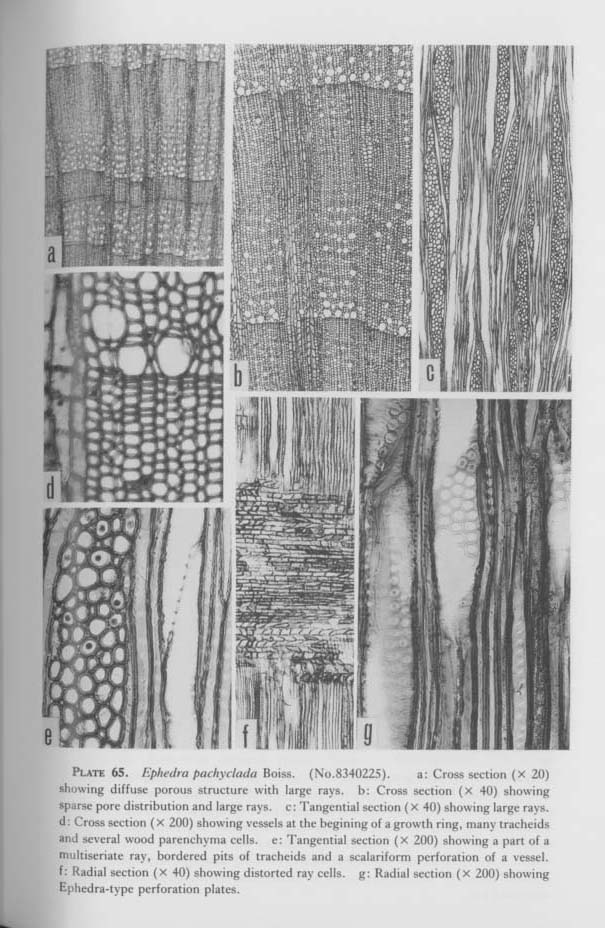
A large shrub larger than the previous species, growing from the dry temperate zone to sub-alpine zone.
SPECIMENS. No. 8340222, d=6 cm, h=1 m, alt. 2560 m: Kali Gandaki, Kalopani (2570 m)-Ghatte Khola (2570 m)-Larjung (2600 m)-Tukche (2680 m), H. Ohba et al., July 18,1983. No. 8240225*, d=6 cm, h=1.5 m, alt. 2600 m: Kali Gandaki, Tukche (2680 m)-Marpha (2710 m)-Jomson (2750 m), H. Ohba et al., July 19, 1983.
DESCRIPTION. A diffuse porous wood with indistinct growth rings. Growth rings are defined by differences of pore size, pore density and diameter of tracheids between the outermost late wood and the following early wood; width is narrow, 0.2-0.8 mm.
Pores are not few and most are distributed in the early wood; polygonal in outline and small, 25-50 and 10-45 µm in radial and tangential diameters respectively; pore size reduced gradually from the beginning of the growth rings towards outer portion. To distinguish vessels from the tracheids in cross section in the late wood is difficult; thin-walled (about 4 µm). Vessel elements are medium in length, 550-800 µm Perforation plates are reticulate or so-called Ephedra-typa with round perforations; 5-20 or more perforations arranged alternately in 1-3, mostly 2, rows in the plates; perforations with narrow borders. Intel-vessel pits and pits into tracheids are round in outline and the same in size and shape as the perforations, and the bordered pits of the conifers ; with distinct torus. Coarse spiral-like thickenings are present.
Non-perforated tracheal elements are tracheids or "vessel tracheids". They are easily distinguished in the early wood vessels by means of pore size and the presence of spiral-like thickenings, but with difficulty in the late wood because of similarity in size and shape. Tracheids are small and polygonal or square in cross section; 8-25 and 8-25 µm in radial and tangential diameters respectively; fairly flattened at the margin of growth rings. Bordered pits are round in outline with, distinct torus; abundant in radial and also in tangential walls; a little smaller than those on the vessel walls. Spiral thickenings are invisible.
Wood parenchyma are rather abundant but to recognize them in cross section is quite difficult; very long fusiform or in strands with mostly two cells; crystals invisible.
Rays are distinctly heterogeneous and coarse; mostly multiseriate and rarely uniseriate. Uniseriate rays are made of wholly upright cells; 1-10 cells and 45-350 µm or more in height. Multiseriate rays are very large; 2-7, mostly 4-6, cells (30-140 µm) in width and very high (up to 2.5 mm or more); consisting of upright, square and procumbent cells. Ray cells in tangential section are quite variable in size and shape; upright and square cells are slender or distorted fusiform, triangular or elliptical in tangential section and distorted rhombic or quadrilateral with undulating walla in radial section; 35-75, 15-25 and 20-60 µm in vertical, tangential and radial diamettsrs respectively. Procumbent cells are oval or polygonal in tangential section and distorted rectangular or quadrilateral with undulating horizontal walls in radial section; 15-30, 15-30 and 35-135 µm in vertical, tangential and radial diameters respectively. Crystals are invisible. Ray-vessel pita are not prominent; sparsely dispersed in the fields; small elliptical (less than 5 µm in diameter) with slit-like apertures.
ERICACEAE (Mitsuo SUZUKI)
Agapetes serpens (Wight) Sleumer [Plate 66]
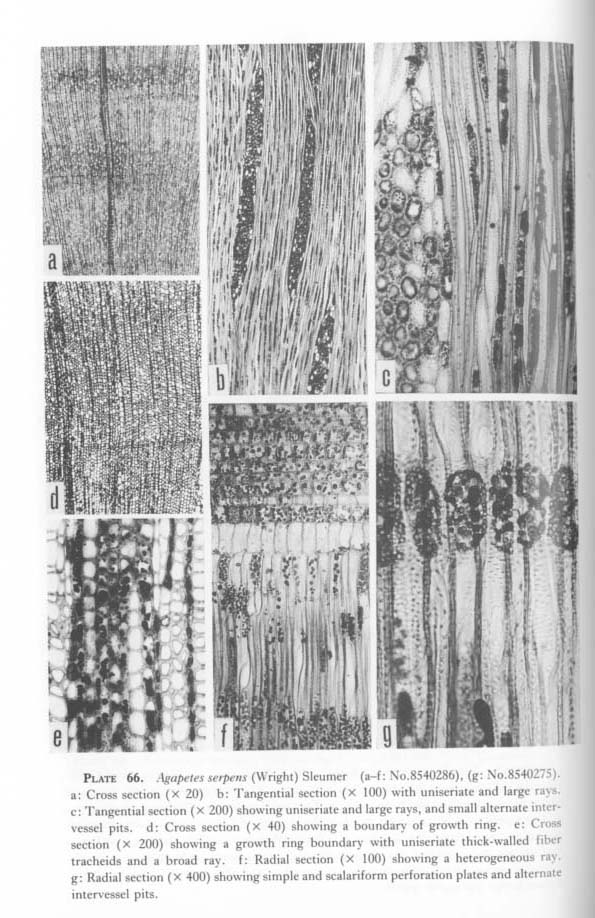
A small epiphytic shrub on the trunk of large trees growing from the sub-tropical to the temperate zones.
SPECIMENS. No. 8540275, d=1.5 cm, h=1.2 m; No. 8540276*, d=3 cm, h=1.8 m, both on the trunk of Alnus nepalensis, alt. 1860 m: Namikhil (2300 m)-Chamare (1900 m)-Likhu (a bridge, 1550 m)-Bhandar (2300 m), H. Ohba et al., Sept. 10, 1985.
DESCRIPTION, Wood is diffuse porous with very small pores and conspicuous rays.Growth rings are present but indistinct; 0.3-1.0 mm in width.
Pores are a little abundant in the early wood but more scarce in the late wood; two to several pores in a radial multiple or solitary; polygonal in outline and very small (20-35 and 15-30 µm in radial and tangential diameters respectively); thin-walled (about 1.5 µm). Vessel elements are short (200-500 µm); perforation plates are predominantly simple and often scalariform with not so many bars (one to several, sometimes up to 20 bars). Intervessel pits are small (about 3 µm in diameter) and round with elliptical or slit-like apertures; arranged alternately with spaces. Spiral thickenings are invisible.
Non-perforated tracheal elements are fiber tracheids. Fiber tracheids constitute the ground mass of wood but to distinguish fiber tracheids from small pores and wood parenchyma is very difficult because of their quite similar size. Fiber tracheids are numerous, especially in the late wood; rectangular to polygonal in outline (8-25 and 8-22 µm in radial and tangential diameters respectively) with a little thicker walls (1.5-2.5 µm) than pores; septate with very thin septa; bordered pits are numerous and small with slit-like apertures.
Wood parenchyma is diffused and rather scarce; usually in strands with several cells; crystals are invisible.
Rays are conspicuously large and uniseriate; typically heterogeneous. Uniseriate rays consist mostly of one to five very high upright cells; upright cells are 60-110, 8-10 and 17-30 µm in vertical, tangential and radial diameters respectively. Large rays are constituted from upright and square cells but lack entirely procumbent cells; very high (up to 3 mm) or low (about 0.5 mm) because of dissection of higher rays; 100-150 µm and 5-10 cells in width; cells are variable in size and their outlines in tangential section are quite asymmetrical; 10-90, 12-35 and 15-40 µm in vertical, tangential and radial diameters respectively. Ray-vessel pits are numerous and arranged alternately; the pits in upright cells are quite dense and contiguous, forming reticulate or scalariform perforation plate-like patterns; round to horizontally longelliptical with distinct borders, 2-12 µm in horizontal diameter. Crystals are invisible in any kinds of cells.
Enkianthus deflexus (Griff.) Schneid. [Plate 67]

A small deciduous tree growing from the upper temperate zone to the sub-alpine zone.
SPECIMEN. No, 8340453*, d=7 cm, h=3 m, alt. 2670 m; Rolwaling Khola, Simigsion (1950 m)-Sekpa (2300 m)-Kyalche (2700 m), H. Ohba et al., Aug. 31, 1983.
DESCRIPTION. Wood is diffuse porous with small pores. Growth rings are present but indistinct; a tangential uniseriate band of very thick-walled fibers defines the growth ring boundary; 1.1-2.1 mm in width.
Pores are abundant and arranged in many narrow tangential concentric bands; usually in tangential multiple and sometimes solitary; the pore bands are made of one or two pores in radial thickness; polygonal and angular in outline and small; large pores in the early wood are about 80 and 60 µm in radial and tangential diameters respectively, while small pores at the outermost late wood are 40-12 and 30-15 µm inradial and tangential diameters respectively; thin-walled (less than 1,5 µm in thickness). Vessel elements are rather short to long (400-800 µm); perforation plates are mostly scalariform with fine numerous bars (about 30 bars) and sometimes reticulate. Intervessel pits are usually observed on the radial walls; small oval to horizontally long elliptical (about 3 µm in vertical diameter and 5-10 µm in horizontal diameter) with slit-like apertures; densely arranged alternately. Spiral thickenings are invisible.
Non-perforated tracheal elements are fiber tracheids and libriform fibers. Fiber tracheids constitute the ground mass of the wood; polygonal in outline (10-25 and 10-30 µm in radial and tangential diameters respectively) with a little thicker walls (about 2.5 µm); bordered pits are numerous and small with slit-like apertures, Libriform fibers are in uniseriate tangential bands and restricted at terminal of growth rings; rectangular in cross section (5-12 and 10-30 µm in radial and tangential diameters respectively); thick-walled (3-12 µm in thickness of tangential walls); quite narrow lumens with very fine simple pits.
Wood parenchyma is vasicentric and constitutes the concentric bands with pores; usually at the abaxial side of pores in a uniseriate band; diameters in cross section are nearly the same or a little large than. those of fiber tracheids but the walls are thinner than the fiber tracheids; usually in strand with several cells; very fine pits are in primary pits fields on radial walls; crystals are invisible.
Rays are typically heterogeneous; uniseriate and multiseriate. Uniseriate rays consist of 1-15 very high upright cells (80-520 µm or more high); upright cells are 30-90, 20-30 and 20-30 µm in vertical, tangential and radial diameters respectively. Multiseriate rays consist of central cores of procumbent cells and uniseriate wings of upright and square cells; 2-4 or 5 cells and 25-80µm in width and 300-1250 µm or more in height; uniseriate wings are usually of one to three cells and often become very high (five or more cells); procumbent cells arc small oval in tangential section (10-25 µm in diameter) and long (up to 250 µm or more in radial diameter). Crystals are invisible in any kinds of ray cells. Ray-vessel pits are numerous and alternate; smaller than the intervessel pits and half-bordered with slit-like apertures.
Lyonia ovalifolia (Wall.) Drude, 'green form' [Plate 68]

A deciduous tree growing in the temperate zone.
SPECIMENS. No. 8340067, alt. 1960 m: Gandaki Zone, Pokhara Diat., Puthana (Dhampus, 2050 m)-Tolka (1850 m), H. Ohba et al., July 8, 1983. No. 8340509*, d=25 cm, h=12m, alt. 2180 m; Phedi Kharka (2100 m)-Koplang (2100 m)-Khanigaon (1700m), H. Ohba et al., Sept. 14,1983.
DESCRIPTION. Wood is diffuse porous with small pores, sometimes with pith flecks. Growth, rings are present and moderately distinct; the difference in pore size between the outermost late wood and the following early wood and tangentially flattened and thick-walled fiber tracheids at the terminal define the boundary of growth rings; width variable, 0,9-4.1 mm.
Pores are abundant and evenly distributed with a tendency to be in tangential bands, especially in the late wood; pores are solitary, in small multiples or in small clusters; pore size is reduced gently from the beginning to the end of the growth rings; 30-88 and 22-72 µm in radial and tangential diameters respectively; polygonal or rectangular in outline with thin walls (about 1.5 µm in thickness). Vessel elements are short (250-450 µm); perforation plates are exclusively scalariform with fine bars at a little wide intervals; bars mostly 9-30 and more numerous with very narrow intervals in the vessels at the end of growth rings. Intervessel pits are sometimes observed; arranged alternately with narrow spaces and sometimes scalariform; small round (about 3 µm
in diameter) to horizontally long-elliptical with slit-like apertures. Spiral thickenings are faintly observed on the inner walls, while more distinct at the ligulate ends.
Non-perforated tracheal elements are fiber tracheids. Fiber tracheids constitute the ground mass of wood; polygonal or rectangular in outline (10-25 and 10-25 µm in radial and tangential diameters respectively), and become natter at the terminal of growth rings; with thick walls (4-5 ,µm); bordered pits are quite similar to intervessel pits or a little smaller; spiral thickenings are invisible.
Wood parenchyma is a little abundant; diffuse and diffuse-in-aggregate; size in cross section is a little larger with thinner walls than the fiber tracheids; crystals invisible.
Rays are heterogeneous; uniseriate and multiseriate. Uniseriate rays are very high and made up entirely of upright cells; 1-18 cells and 50-1190 µm, or more in height. Multiseriate rays are 2-4, mostly 3 or 4 cells wide (20-70 µm) and 180-850 µm or more in height; made of multiseriate central core of procumbent cells and uniseriate wings of square and upright cells; uniseriate wings are usually low, mostly with one or two cells, but sometimes become very high by fusion of uniseriate rays. Upright and square cells are quite slender elliptical, fusiform or triangular in tangential section; 30-130, 8-25 and 15-45 µm in vertical, tangential and radial diameters respectively. Procumbent cells are oval or vertically long-elliptical in tangential section; 10-28, 8-20 and 50-125 µm in vertical, tangential and radial diameters respectively. Crystals are invisible in any ray cells. Ray-vessel pits are numerous; arranged alternately; oval or horizontally long-elliptical with horizontally long slit-like apertures; smaller than the intervessel pits.
Lyonia ovalifolia (Wall.) Drude, 'white form' [Plate 69]

A deciduous tree growing in the temperate zone.
SPECIMENS, No. 8340069, alt. 1980 m: Gandaki Zone, Pokhara Dist., Pathana (Dhampus, 2050 m)-Tolka (1850 m), H. Ohba et al., July 8, 1983. No. 8340437*, d=25 cm, h=8m, alt. 2200 m; No. 8340454, d=5 cm, h=3 m, alt. 2670m: Rolwaling Khola, Simigaon (1950 m)-Sekpa (2300 m)-Kyalche (2700 m), H. Ohba et al., Aug. 31, 1983.
DESCRIPTION. Wood is diffuse porous with small pores and sometimes with pithflecks. Growth rings are present and moderately distinct; the difference of pore size between the outermost late wood and the following early wood and tangentially flattened and thick-walled fiber tracheids at the terminal define the boundary of growth rings; width quite narrow to narrow, 0.05-1.1 mm.
Pores are abundant and evenly distributed with some tendency to be in tangential bands especially in the late wood; solitary, in small multiples or in small clusters; pore size is reduced gently from the beginning to the end of the growth rings; 20-68 and 22-25 µm in radial and tangential diameters respectively; polygonal or rectangular in outline with thin walls (about 1.5 µm in thickness). Vessel elements are short to medium (330-640 µm); perforation plates are exclusively scalariform with fine bars at a little wide intervals; bars mostly 13-23 and more numerous with very narrow intervals in the vessels at the end of growth rings. Intervessel pits are arranged alternately with narrow spaces or in scalariform; small round (about 3 µm in diameter) to horizontally long-elliptical with slit-like apertures. Spiral thickenings are faintly observed on the inner walls, while more distinct at the ligulate ends.
Non-perforated tracheal elements are fiber tracheids. Fiber tracheids constitute the ground mass of wood; polygonal or rectangular in outline (10-25 and 10-25 µm in radial and tangential diameters respectively), and become strongly flattened at the terminal of growth rings; with a little thick walls (4-5 µm); bordered pits are quite similar to intervessel pits or a little smaller than those; spiral thickenings are invisible.
Wood parenchyma is a little abundant; diffuse and diffuse-in-aggregate; size in cross section is a little larger with thinner walls than the fiber tracheids; crystals invisible.
Rays are heterogeneous; uniseriate and multiseriate. Uniseriate rays are very high and consist entirely of upright cells; 1-18 cells and 45-1320 µm or more in height. Multiseriate rays are 2-5, mostly 4 cells wide (26-85 µm) and 300-1150 µm or more in height; made up of a multiseriate central core of procumbent cells and uniseriate wings of square and upright cells; uniseriate wings are usually low mostly with one or two cells which sometimes become very high by fusion of uniseriate rays. Upright and square cells are quite slender elliptical, fusiform or triangle in tangential section; 40-150, 8-25 and 15-60 µm in vertical, tangential and radial diameters respectively. Procumbent cells are oval or polygonal in tangential section; 8-30, 8-30 and 60-160 µm in vertical, tangential and radial diameters respectively. Crystals are invisible in ray cells. Rayvessel pits are numerous and dense; arranged alternately; oval or horizontally longelliptical with horizontally long slit-like apertures; smaller than the intervessel pits.
Lyonia villosa (Hook. f.) Hand.-Mazz. [Plate 70]
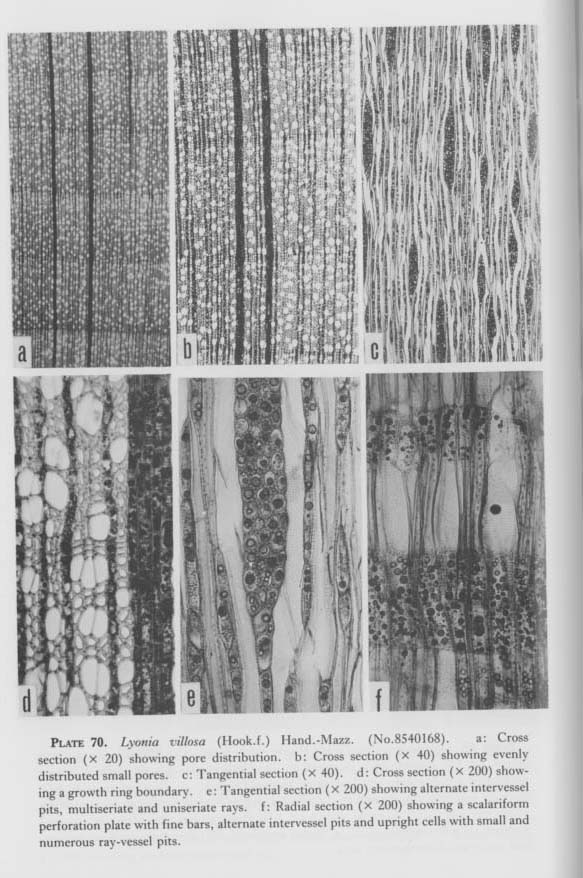
A deciduous tree growing in the temperate zone.
SPECIMENS. No. 8540113, d=15 cm, h=4.5 m, alt, 3320 m; Bagmati Zone, Rasuwa Dist., Gopte (3350 m)-Bahda Kharka (3410 m)-Kutumsang (2450m), M. Suzuki & S. Noshiro, June 3, 1985. No, 8540168*, d=15 cm, h=4 m, alt. 3550m: Janakpur Zone, Dolakha Dist., Serdingma (3400 m)-Dubikharka (3720 m), H. Ohba et al., July 7, 1985.
DESCRIPTION. Wood is diffuse porous with small pores. Growth rings are present and moderately distinct; the difference of pore size between the outermost late wood and the following early wood and tangentially flattened and thick-walled fiber tracheids at the terminal define the boundary of growth rings; width quite narrow to narrow, 0.05-1.5 mm.
Pores are abundant and quite evenly distributed or with some tendency to be in tangential bands in the late wood; solitary or in amall tangential or radial multiples with two to several pores; pore size is reduced gently from the beginning to the end of the growth rings; 20-65 and 15-45 µm in radial and tangential diameters respectively; polygonal or rectangular in outline with thin walls (about 1.5 µm in thickness). Vessel elements are short to medium (300-550 µm); perforation plates are exclusively scalariform with fine bars at a little wide intervals; bars mostly 12-18 and more numerous with very narrow intervals in certain vessels. Intervessel pits are arranged alternately with narrow or a little wide spaces, or in scalariform; small round (about 3 µm in vertical diameter) to horizontally long-elliptical with slit-like apertures. Spiral thickenings are faintly observed on the inner walls, while more distinct at the ligulate ends.
Non-perforated tracheal elements are fiber tracheids. Fiber tracheids constitute the ground mass of wood; polygonal or rectangular in outline (12-20 and 10-220 µm in radial and tangential diameters respectively), and become flattened at the terminal of
growth rings; with thin walls (about 2.5 µm); bordered pits are small and oval in shape with slit-like apertures; spiral thickenings are invisible.
Wood parenchyma is rather scarce; diffuse and diffuse-in-aggregate; size in cross section is a little larger with thinner walls than the fiber tracheids; crystals invisible.
Rays are heterogeneous; narrow and broad. The narrow rays are uniseriate or biseriate, very high and made up of entirely upright cells; 1-16 cells and 55-1100 µm or more in height. Multiseriate rays are 3-5, mostly 4, cells wide (30-75 µm) and 300-900 µm in height or sometimes more with very high uniseriate wings; made of a multiseriate central core of procumbent cells and uniseriate wings of square and upright cells; uniseriate wings are usually low, mostly with one or two cells, but sometimes become very high. Upright and square cells are quite slender elliptical, fusiform or triangle in tangential section; 50-130, 10-25 and 15-50 µm in vertical, tangential and radial diameters respectively. Procumbent cells are oval or polygonal in tangential section; 10-35, 10-25 and 45-150 µm in vertical, tangential and radial diameters respectively. Crystals are invisible in any ray cells. Ray-vessel pits are numerous and dense; arranged alternately; oval or horizontally long-elliptical with horizontally long slit-like apertures; smaller than the intervessel pits.
Pieris formosa (Wall.) D. Don [Plate 71]

An small evergreen tree growing from the upper evergreen broad-leaved forests to sub-alpine zone.
SPECIMENS. No. 8340128, d=18 cm, h=5 m, alt. 2620 m: Dhaulagiri Zone, Parbat Dist., Ghandruk Deorali (2530m)-Banthanti (2650 m), H. Ohba et al., July 11, 1983. No. 8340317*, d=12 cm, h=2m, alt. 2670m, and No. 8340319, d=10cm, h=4m, alt. 2670 m: Marsyandi Khola, Chame (2630 m)-Qupar (2530 m)-Thangjo (2580 m)-Dhanagyang (2200 m), H. Ohba et al., Aug. 6, 1983. No. 8540070, d=12 cm, h=4 m, alt. 3040m: Bagmati Zone, Rasuwa Dist., Langtang (3380 m)-Ghora Tabela (3000 m)-Lama Hotel (2480 m), M. Suzuki & S. Noshiro, May 29, 1985.
DESCRIPTION. Wood is diffuse porous with very small pores and often with pith flecks. Growth rings are present but indistinct; one to several rows of flattened fiber tracheids define a growth ring boundary; 0.1-2.5 mm in width.
Pores are abundant and evenly distributed in early wood with a tendency to be arranged in tangential bands in the late wood; usually solitary or in tangential multiples; the tangential pore bands are mostly one row in radial thickness; polygonal and angular in outline and very small; 12-40 and 10-40 µm in radial and tangential diameters respectively; with very thin walls (less than 1 µm in thickness). Vessel elements are short [200-350 µm); perforation plates are predominantly simple or acalariform with several [less than 10) bars or sometimes reticulate. Intervessel pits are rather sparse and abserved on the radial walls; small oval to horizontally long-elliptical (about 3 µm in vertical diameter and 5-10 µm in horizontal diameter) with slit-like apertures; arranged in alternate. Spiral thickenings are distinct on the entire inner walls.
Non-perforated tracheal elements are fiber tracheids. Fiber tracheids constitute the ground mass of wood; polygonal or rectangular in outline (10-20 and 8-25 µm in radial and tangential diameters respectively), flattened especially at the terminal of growth -ings (less than 6 µm in radial diameter); with thin walls (about 2 µm); bordered pits are small with slit-like apertures; spiral thickenines are invisible.
Wood parenchyma was not seen.
Rays are heterogeneous and small; 1-3 cells or 15-40 µm in width and 30-500µm in height. Upright and square cells are slender-elliptical, fusiform or triangle in tangential section; 30-100, 10-15 and 30-60 µm in vertical, tangential and radial diameters respectively. Procumbent cells are oval or vertically long-elliptical in tangential section; 10-20, 10-25 and 40-110 µm in vertical, tangential and radial diameters respectively. Crystals are invisible in any ray cells. Ray-vessel pits are numerous and arranged alternately ; horizontally long-elliptical with slit-like apertures.



















